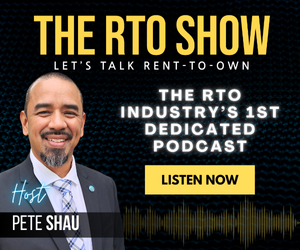O’ROURKE PRESIDENT ANDREW TERRY DIVES DEEP INTO THE DATA TO HELP YOU STRATEGIZE FOR SUCCESS IN 2022, 2023, AND BEYOND
O’Rourke Sales Company President Andrew Terry is a numbers nerd at heart. With University of Vermont degrees in both Business Administration and Economics, Terry began his career in data analysis before transitioning into electronics – heading LG Electronics’ North American sales division – and appliances, as a Senior Vice President for H.H. Gregg. For the past five years, Terry has led O’Rourke, one of the country’s largest national distributors of appliances, electronics, and outdoor and technology products. And he does it mostly by the numbers – happily analyzing market data to identify trends and strategize actions.
So when Terry presented How to Be a Better Buyer: Supply Chain and Product Trends during this year’s RTO World, he did so with a deck of detailed charts and graphs he had to (rather gleefully) interpret for his audience of rent-to-own operators. But Terry also masterfully outlined what dealers need to know about the market today, tomorrow, and into Q1 of next year in order to make their best buying decisions for sustained success.
Appliances
But, warns Terry, retail business estimates for this year and next are down – projections show appliances biz lower by 6% this year, and another 6-7% next year. Why? Because big-box retailers – like Best Buy, Lowe’s, and Walmart – are all reducing their inventory levels, pushing product back on suppliers because there’s just nowhere to put new inventory.
“At the beginning of 2021, suppliers and manufacturers were scrambling to catch up,” explains Terry. “They were dumping inventory into the market to meet the spike in demand. It drove inventory levels sky-high, and that’s where we are now – as many of you know, finding an open warehouse at a decent cost is almost impossible.
“Best Buy, Home Depot, and Lowe’s make up about 65% of the total U.S. appliance market,” he continues. “Home Depot already does vendor-managed inventory, and Lowe’s has told their major manufacturers that they’re going to reduce their inventory by 1-2 weeks’ worth of product, which is a lot to push back to the suppliers. Meanwhile, Best Buy is moving to a Supplier Direct Fulfillment model, which will push their inventory-carrying costs back to their direct suppliers or distributors.”
So, with in-stock inventory still overflowing and warehousing at capacity, appliance prices should remain extremely low through year’s end, so Terry urges rental dealers to buy now.
“Manufacturers and suppliers are searching for channels where they can move significant quantities of product,” he notes. “There is excess of everything, which translates into huge buying opportunities in entry-level as well as stepup products. I especially recommend investing in step-up laundry, because that’s where you’ll keep up your average selling prices (ASPs). There will be phenomenal prices available through year’s end, but they won’t last much longer. Shipments already reduced significantly during Q2 and Q3 of 2022, and if manufacturers overreact to the lack of demand they’re seeing currently, we might see supply challenges occurring again in Q1 of 2023.
“Be loyal to whoever has taken care of you over the past couple of years,” concludes Terry. “Once we get into next year, it’s going to be a different story. We may be in a situation where the whole supply-demand dynamic is out-of-whack and we’re chasing inventory again.”
Electronics
TUNE INTO TRENDS: PURCHASE BETTER TVS FOR BIGGER PROFITS
Terry clearly doesn’t like invoking the “r word” (recession), but Q1 and Q2 of 2022 by definition created such an economic condition for the U.S.
“We expected to go into Q2 and Q3 with stable pricing – a 5% supply-demand ratio,” says Terry. “That didn’t happen. The GDP was hurting, inflation was hitting. This summer, numbers seem to be turning around, but overall, two down quarters equals recession. So we thought electronics units would be down 10% at this point, but they’re actually double that – down 21%, which again has led to a substantial oversupply in electronics and television.”
As with appliances, big-box retailers are downsizing their inventories by decreasing demand with manufacturers and pushing product back to suppliers. Manufacturers are “right-sizing” production while investing at retail to move inventory.
“Again, this situation is leading to some prime purchasing opportunities for RTO,” Terry asserts. “We’re seeing better pricing on TVs than we’ve seen in a long time. Leverage those deals now, because supply-side adjustments are coming. Manufacturers are risk-averse right now due to the money they’re spending to move product, so they’re not building hopeful inventory anymore.
“There are massive opportunities in entry-level and step-up televisions,” he continues. “The QLED pricing structure is wildly close to the entry-product cost structure at the moment. I recommend investing in QLED rather than entry, because your cost is the same and QLED has tangible features for which you can collect a few more dollars every week – and that’s how you’ll win with ASPs. If you sell a better TV product that delivers a better margin, your overall profitability is going to rise.”
Terry projects TV demand to outpace supply by early next year, but he urges rental dealers to keep their eyes on supplies.
“Watch supply trends closely,” he counsels. “All of a sudden, something will turn economically, and the demand floodgates will open up again. Take advantage of beneficial pricing while you can, because it’s going to flip the other way – it’s just a matter of time.”
Gaming
GET TOP SCORE: KNOW YOUR GAMERS & INVEST IN VR
While the pandemic boosted washer/dryer and television sales, it supercharged the gaming industry, introducing new games and platforms to existing players, and initiating brand-new gamers – who may not be who you think they are.
“Gamer demographics are not what we tend to envision,” Terry affirms. “It’s important to understand that we’re selling to a much broader audience than the stereotypical gamer. They’re not all hoodie-clad, vitamin D-deficient teens and twenties – not by a long shot.
“In fact,” continues Terry, “almost 40% of gamers are 39 years or older, with an average age of 36. And a full 48% are female. So you might want to rethink how you’re marketing and merchandising gaming product, and whether entry- level product is the right sell for the customer you’re dealing with.”
The gaming industry currently splits into three segments: console gaming (about a $33-billion industry); PC gaming (about a $40-billion industry); and mobile gaming (about a $65-billion industry).
“Console gaming is expected to grow 8-10% over the next five years,” quotes Terry. “PC – which is already bigger than console – is projected to grow 12-15% for the next five years, which is $4.5 billion per year. And mobile gaming, the growth is exponential. Unfortunately, that’s the hardest segment for rent-to-own to leverage, because so much of it is just downloaded in an app.”
But the Next Big Thing in gaming, according to Terry (and his numbers), is cloud and Virtual Reality (VR) gaming. VR gaming will impact not only console and PC, but also mobile gaming. And it offers an excellent entry point for RTO: VR headsets. This year, there are an estimated 20.3 million headset users in the U.S., generating a nationwide market worth $4.8 billion – and that’s forecast to grow by almost 25% each year for the next decade.
“Within the next two years, there will be more VR headsets sold than TVs in the U.S.,” Terry declares. “Typically, about 32-million televisions are sold annually to Americans, and next year, we anticipate 26.5-million VR headsets to be sold – so by 2024, headsets will overrun TVs. If we don’t start strategizing about how to pursue this business line, then we’re going to miss a tremendous trend. The VR segment is projected to grow by 70% annually for the foreseeable future. We’d be crazy not to go after it.”
Terry recommends rental dealers continue to carry console gaming, but refers to it as “low-hanging fruit – it’s easy, people like it, and they’ll buy it.” He proposes rent-to-own operators dedicate more of their stores to gaming in general and PC gaming in particular, as it’s already bigger and growing faster than console.
“Create multiple full packages within your store following a good-better-best format,” advises Terry. “Have a gaming chair, table, monitor, tower, and headset for each setup. Gaming should occupy more floor space than TV, and sooner than you think it should. Trust me – it’s a gigantically growing category.”
And the biggest giant of all will be VR gaming, which has applications across all platforms – console, PC, and mobile. In an industry where content drives the market, Terry says a new Virtual Reality gaming app is added to the Quest app store every three days.
“The technology behind VR and the cost-compression of a headset are going to be so fast-moving and so aggressive that soon, VR will be something rental dealers can add onto any gaming sale,” concludes Terry. “For now, it’s time to put together your gaming game-plan. Gaming should be a bigger slice of your selling strategy, and should integrate VR since it applies to multiple platforms. I promise you, the stats show this is going to be a game-changer – and the numbers never lie.”
Kristen Card has been a contributing writer for RTOHQ: The Magazine for more than 15 years.









